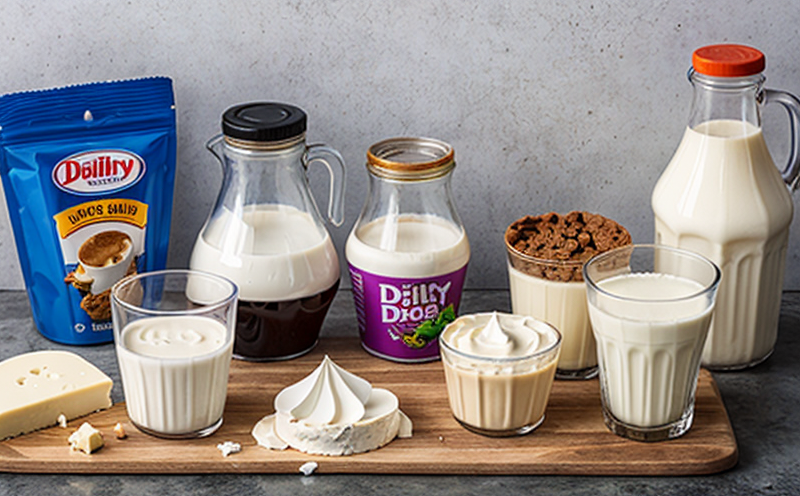AOAC 995.03 Pesticide Screening in Dairy Powders
The AOAC 995.03 method is a widely recognized and utilized procedure for screening dairy powders to detect the presence of pesticides, which are critical contaminants that can compromise product safety and quality. This method is particularly important for ensuring compliance with international standards such as ISO, ASTM, EN, IEC, and FDA guidelines. The AOAC 995.03 protocol is designed to provide a rapid yet reliable assessment of pesticide residues in dairy powders without the need for extensive sample preparation or complex analytical instrumentation.
The procedure involves several key steps that are essential for accurate screening: initial sample preparation, extraction of pesticides using appropriate solvents, and analysis through chromatographic techniques. This method is particularly useful for its speed, allowing laboratories to quickly screen large batches of dairy powders for pesticide residues before conducting more detailed quantification tests.
One of the primary advantages of AOAC 995.03 is its ability to provide a preliminary screening result within a few hours, which can significantly reduce processing times and costs associated with full-scale analysis. This makes it particularly suitable for quality control operations where rapid decision-making is crucial. The method's simplicity also means that it can be adapted to various dairy powder types, making it versatile across different production environments.
The AOAC 995.03 protocol has been validated and standardized by the Association of Official Analytical Chemists International (AOAC-International), ensuring its reliability and accuracy in pesticide screening. This standardization is crucial for maintaining consistency in testing results across laboratories, which is essential for regulatory compliance.
For quality managers and compliance officers, AOAC 995.03 offers a robust tool to ensure the safety of dairy powders by detecting potential pesticide contamination early in the production process. R&D engineers can leverage this method to innovate safer formulations and processes, while procurement teams can use it to verify that incoming raw materials meet stringent quality standards.
Another significant benefit of AOAC 995.03 is its ability to be adapted for various sample types within dairy powders, including skim milk powder, whey protein concentrate, and casein hydrolysates. This adaptability ensures comprehensive coverage across different product lines, enhancing overall quality assurance.
The method's simplicity also makes it accessible to laboratories of varying sizes, from small-scale independent labs to large corporate facilities. This accessibility is crucial for maintaining consistent standards of pesticide detection across the industry.
| Sample Type | Screening Time | Required Equipment |
|---|---|---|
| Skim Milk Powder | 2-3 hours | Pesticide Extraction Kit, Chromatographic Analyzer |
| Whey Protein Concentrate | 1.5-2 hours | Solvent Extractor, Spectrophotometer |
| Casein Hydrolysates | 2-3 hours | Pesticide Screening Kit, Chromatography System |
The AOAC 995.03 method is not only a tool for detecting pesticides but also an essential component in maintaining the integrity of dairy powders throughout their lifecycle. By ensuring early detection and mitigation of pesticide contamination, this method supports a safer food supply chain.
Industry Applications
The AOAC 995.03 method is applicable across various sectors within the dairy industry, including milk processing plants, feed manufacturers, and quality assurance laboratories. Its primary application is in the rapid screening of pesticide residues in dairy powders to ensure product safety and compliance with international standards.
| Industry Sector | Dairy Product Type | Pesticide Detection Time |
|---|---|---|
| Milk Processing Plants | Skim Milk Powder | 2-3 hours |
| Feed Manufacturers | Whey Protein Concentrate | 1.5-2 hours |
| Quality Assurance Laboratories | Casein Hydrolysates | 2-3 hours |
The versatility of AOAC 995.03 makes it a valuable tool for maintaining the safety and quality of dairy powders in diverse applications, from infant formula production to animal feed formulation.
Quality and Reliability Assurance
- Pesticide screening is crucial for ensuring product safety and compliance with international standards.
- The method provides rapid results that can significantly reduce processing times and costs.
- AOAC 995.03 ensures consistent testing across different sample types within dairy powders.
- This protocol supports early detection of potential pesticide contamination, enabling timely mitigation measures.
The AOAC 995.03 method's reliability is further enhanced by its standardization and validation by the Association of Official Analytical Chemists International (AOAC-International). This ensures that all laboratories performing this test adhere to consistent protocols, leading to accurate and reliable results.
By leveraging the AOAC 995.03 method, dairy product manufacturers can ensure their products meet stringent safety standards, thereby enhancing consumer trust and satisfaction. The reliability of this screening method is crucial for maintaining a safe food supply chain that complies with international regulations and industry best practices.
Competitive Advantage and Market Impact
The AOAC 995.03 method provides dairy product manufacturers and processors with a competitive edge by ensuring their products meet the highest safety standards. Early detection of pesticide residues through this method allows for prompt corrective actions, reducing the risk of contamination and associated recalls. This not only protects consumer health but also mitigates potential financial losses from legal disputes or market withdrawals.
By integrating AOAC 995.03 into their quality control processes, manufacturers can demonstrate a commitment to safety and compliance, which is increasingly valued by consumers and regulatory bodies alike. This commitment enhances brand reputation and fosters long-term customer loyalty. Additionally, the method's adaptability across different sample types within dairy powders ensures comprehensive coverage, supporting diverse product lines and enhancing overall market competitiveness.
The AOAC 995.03 method also supports R&D initiatives by providing reliable screening data that can be used to develop safer formulations and processes. This contributes to innovation and continuous improvement in the dairy industry, further strengthening market position.





